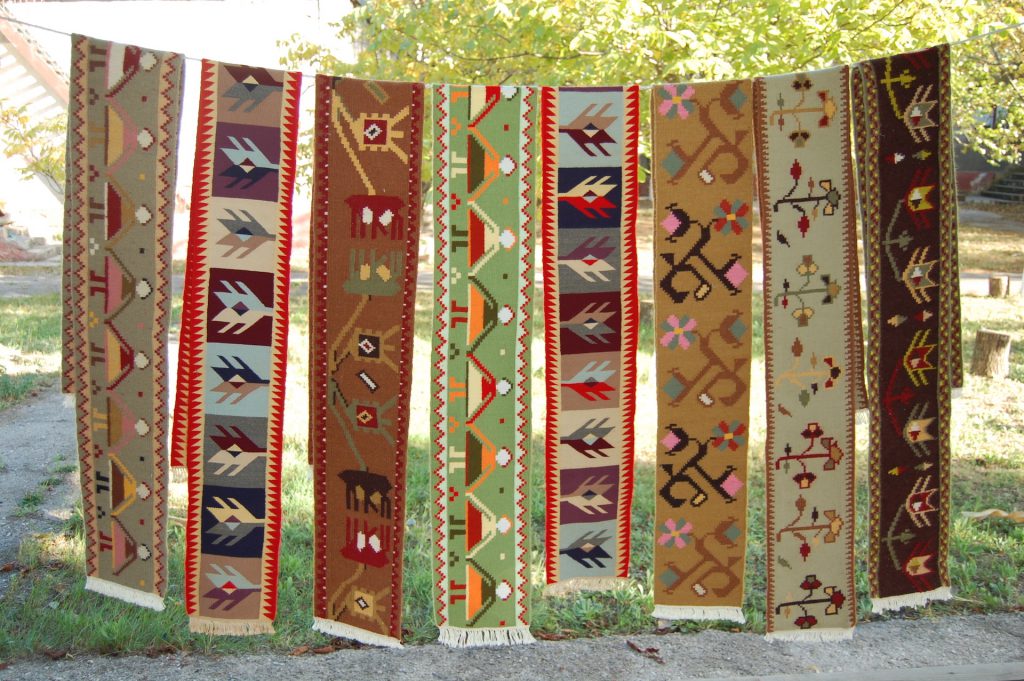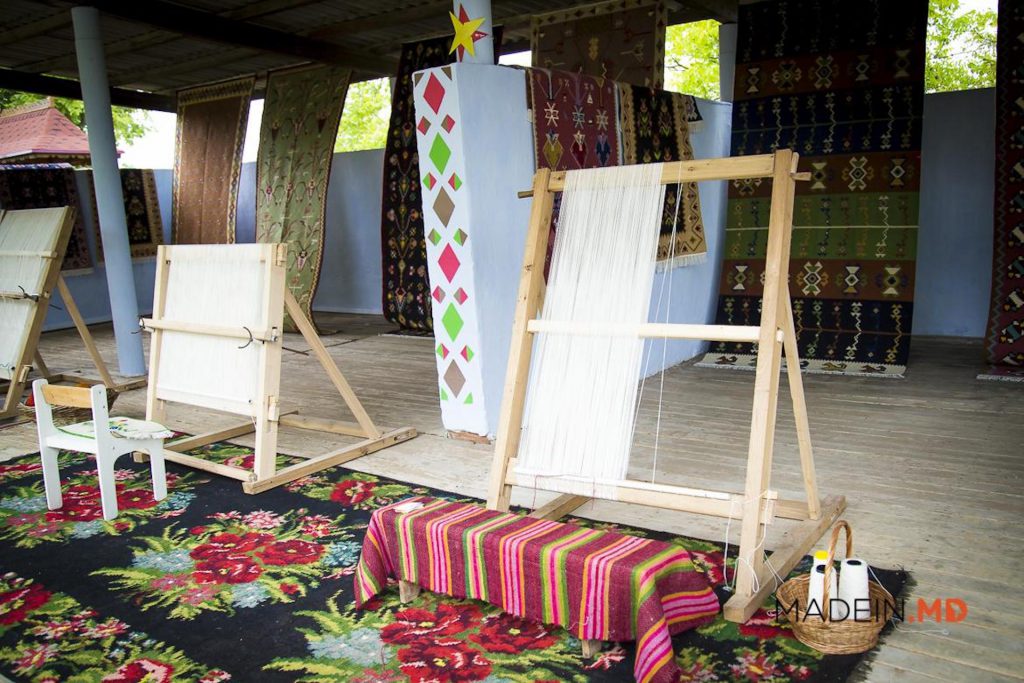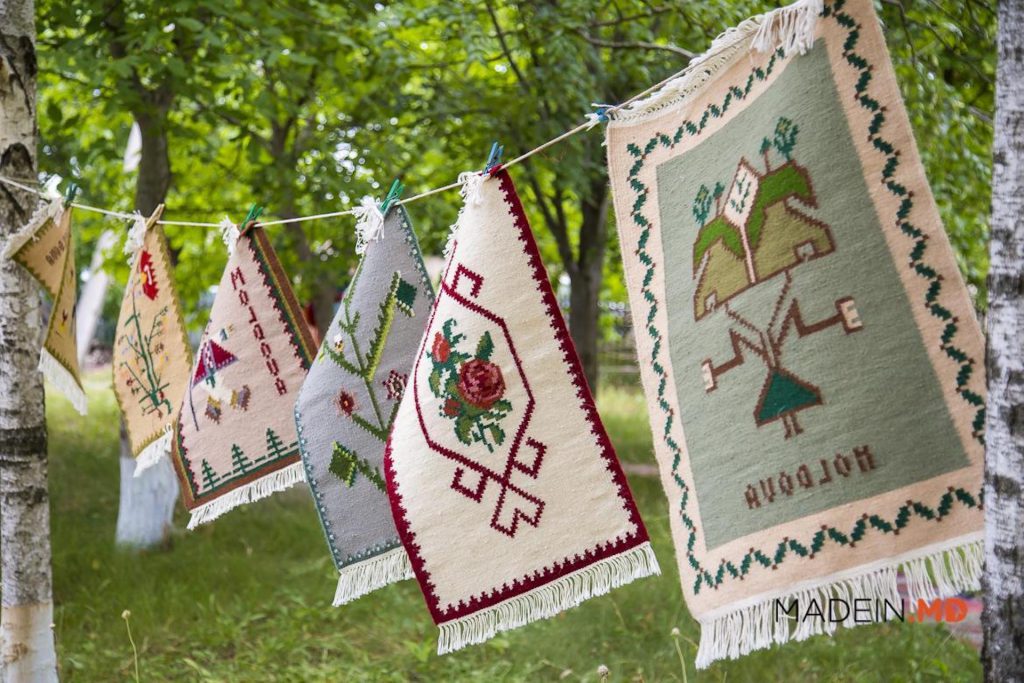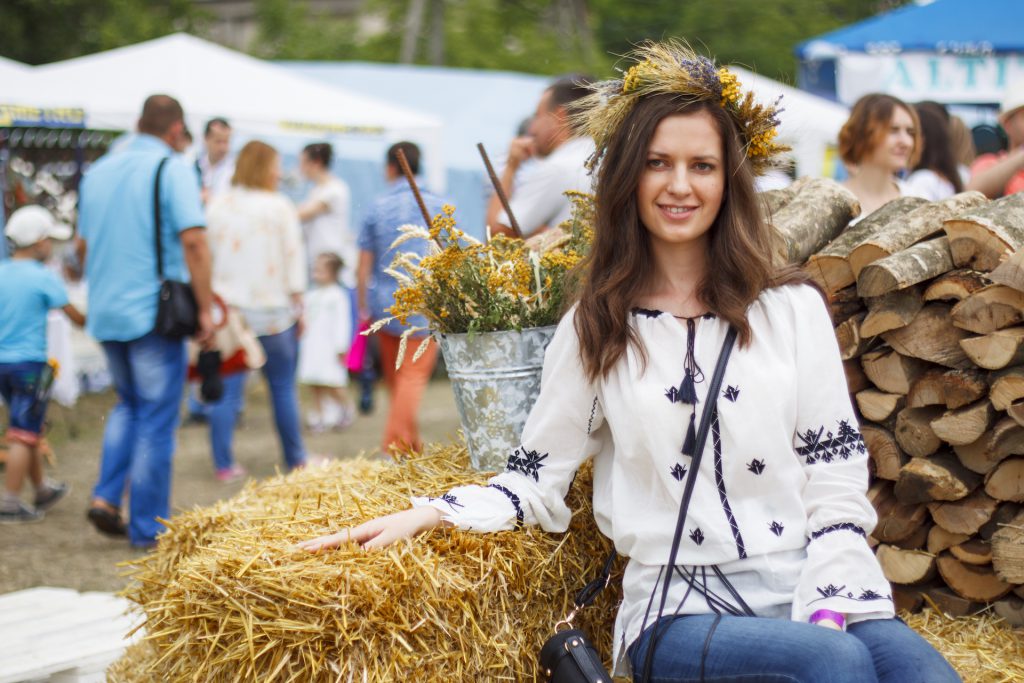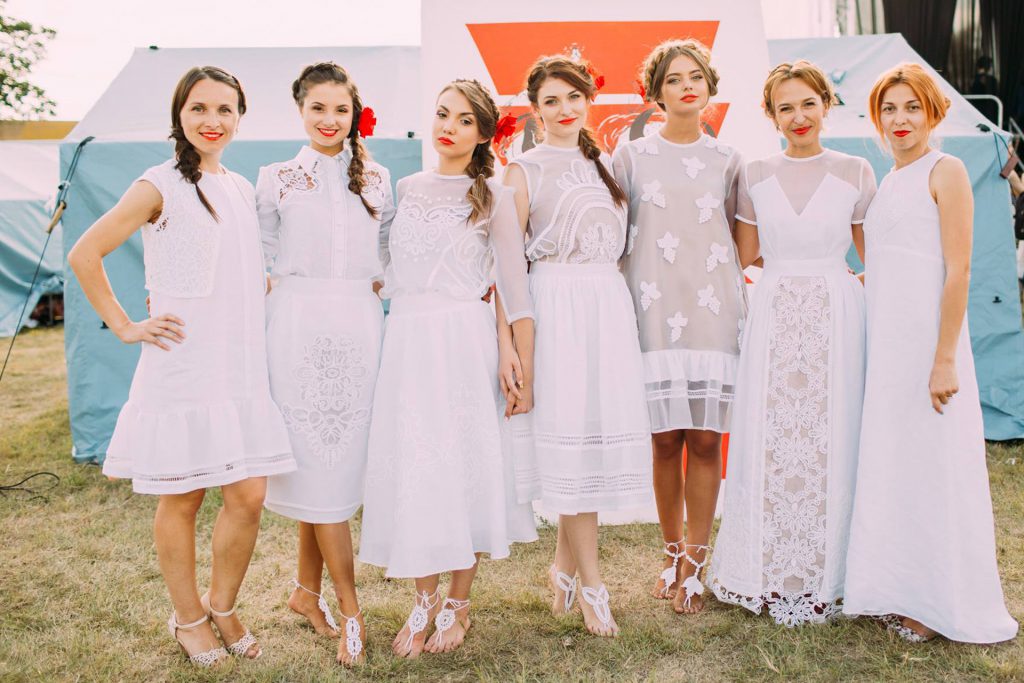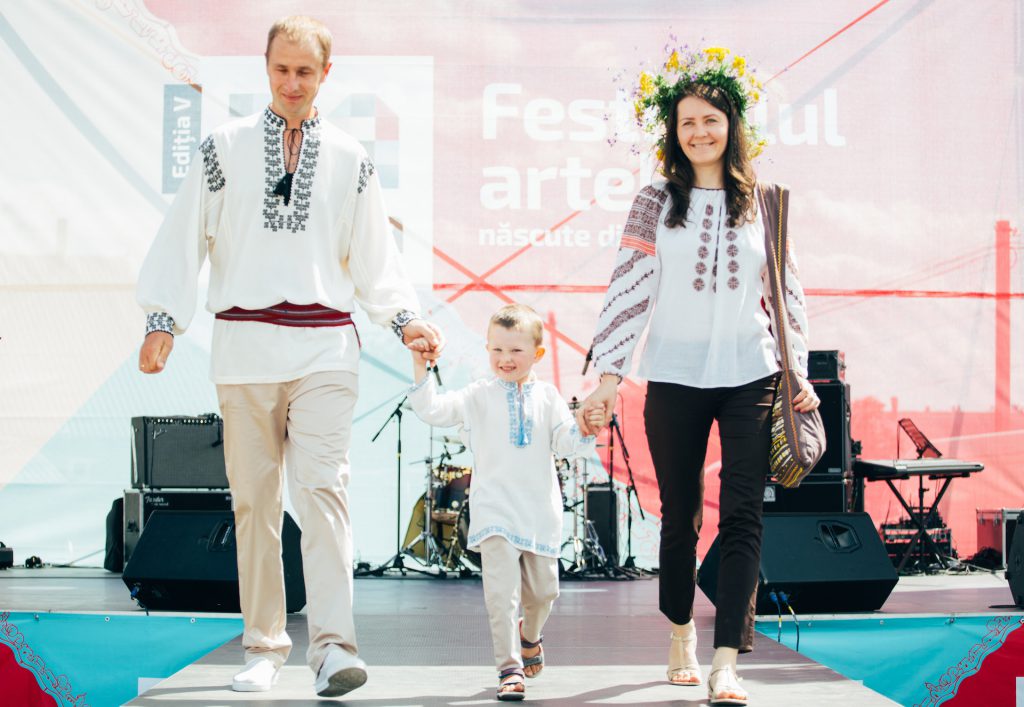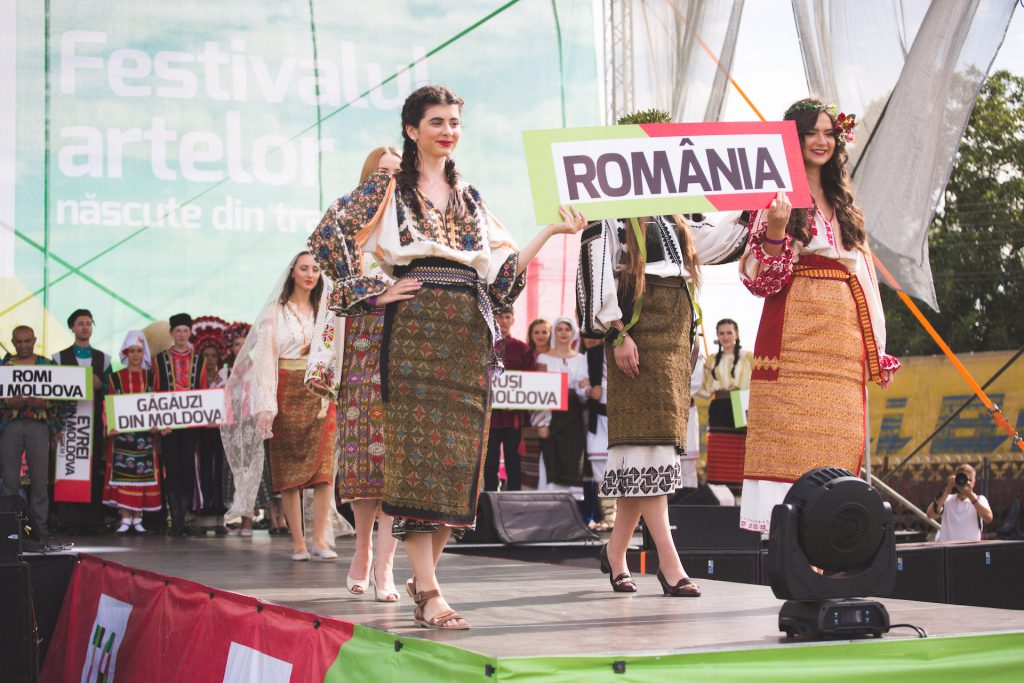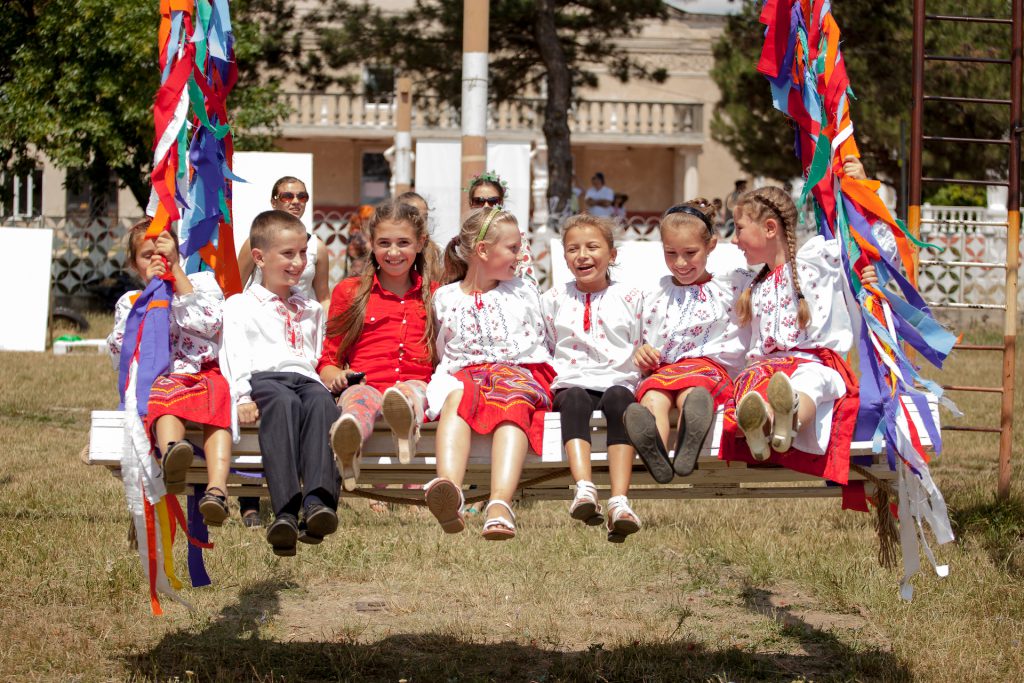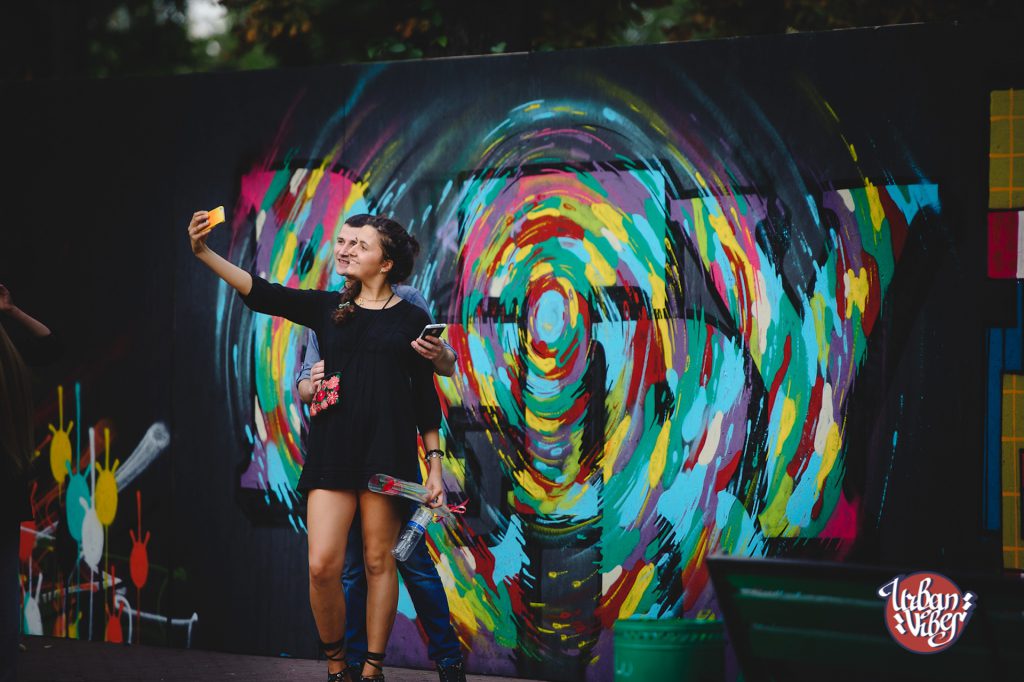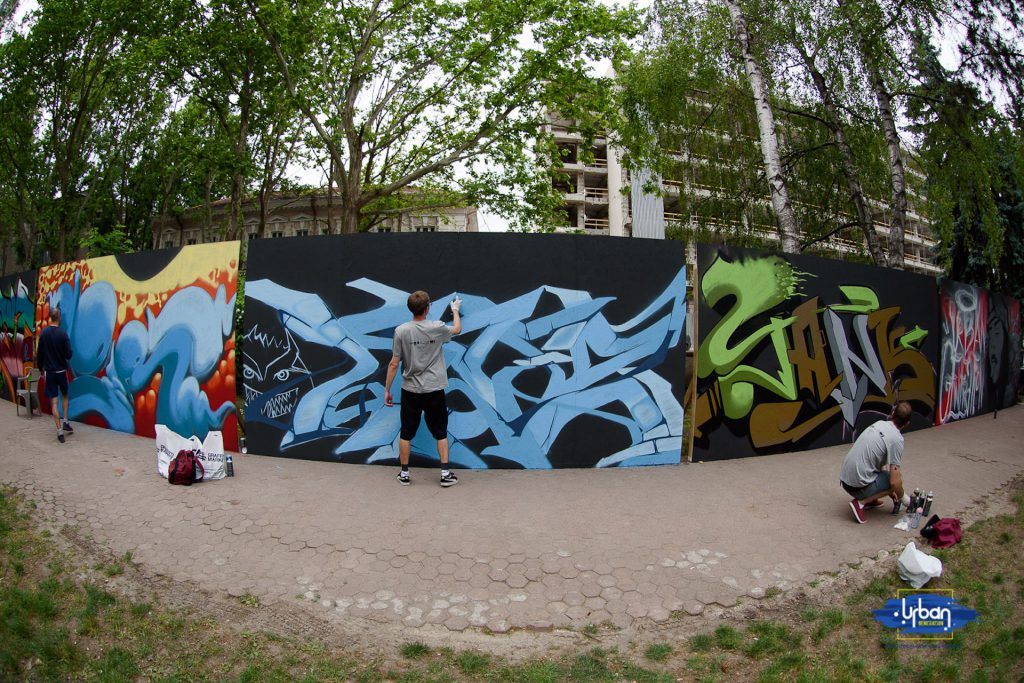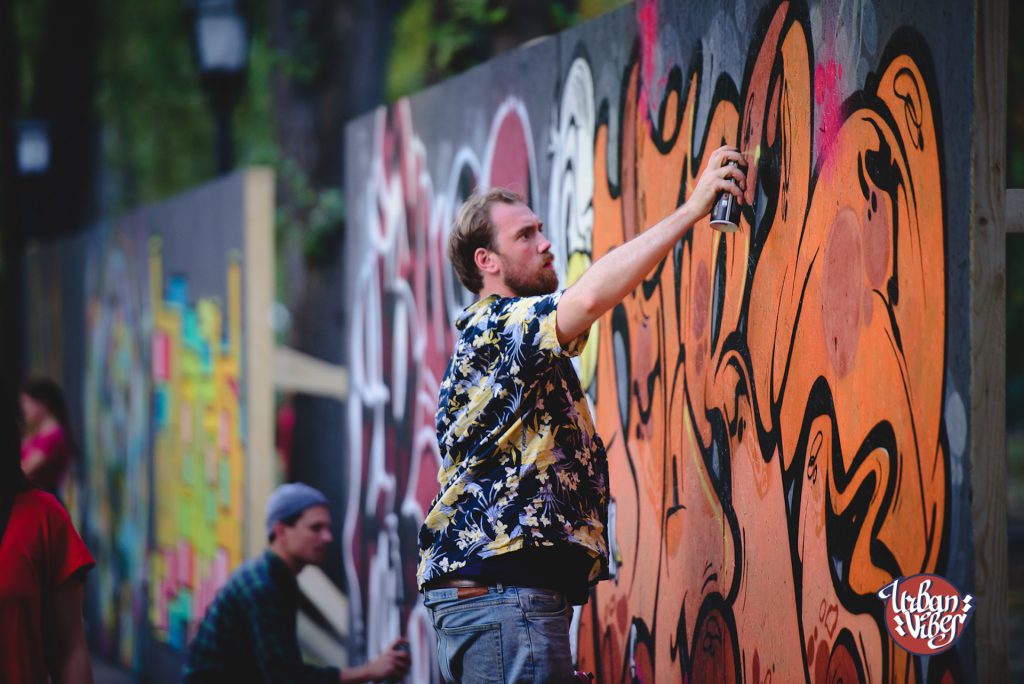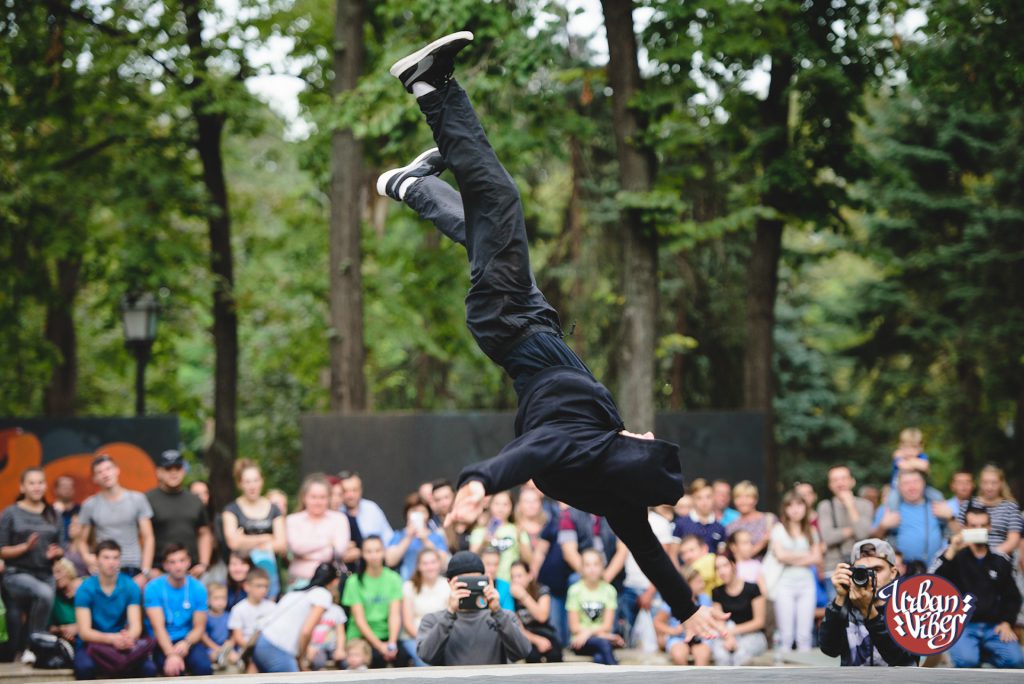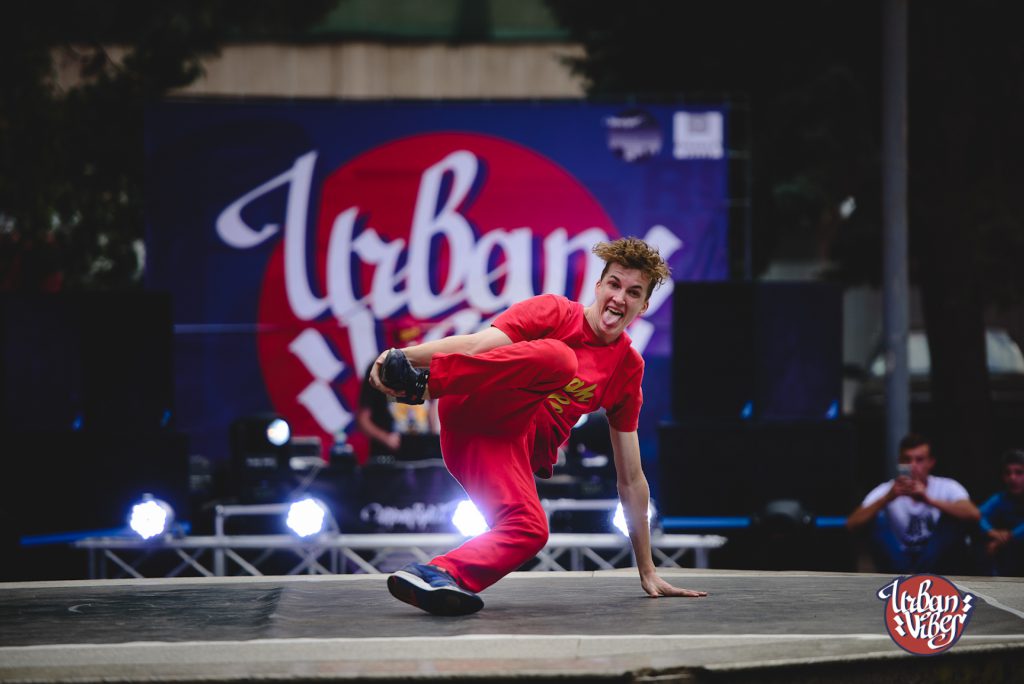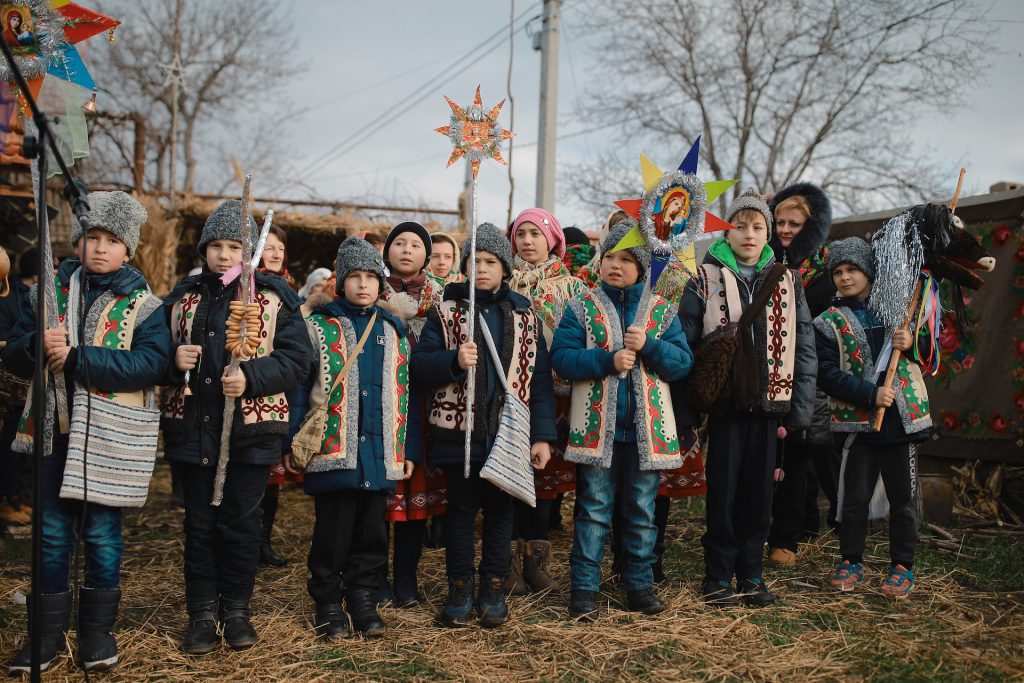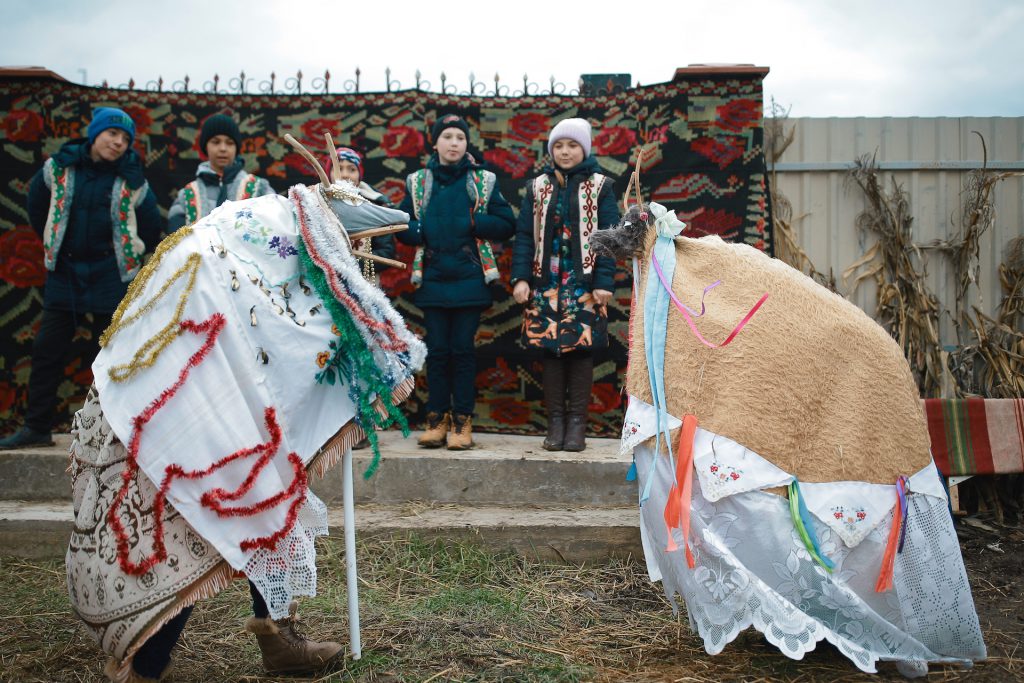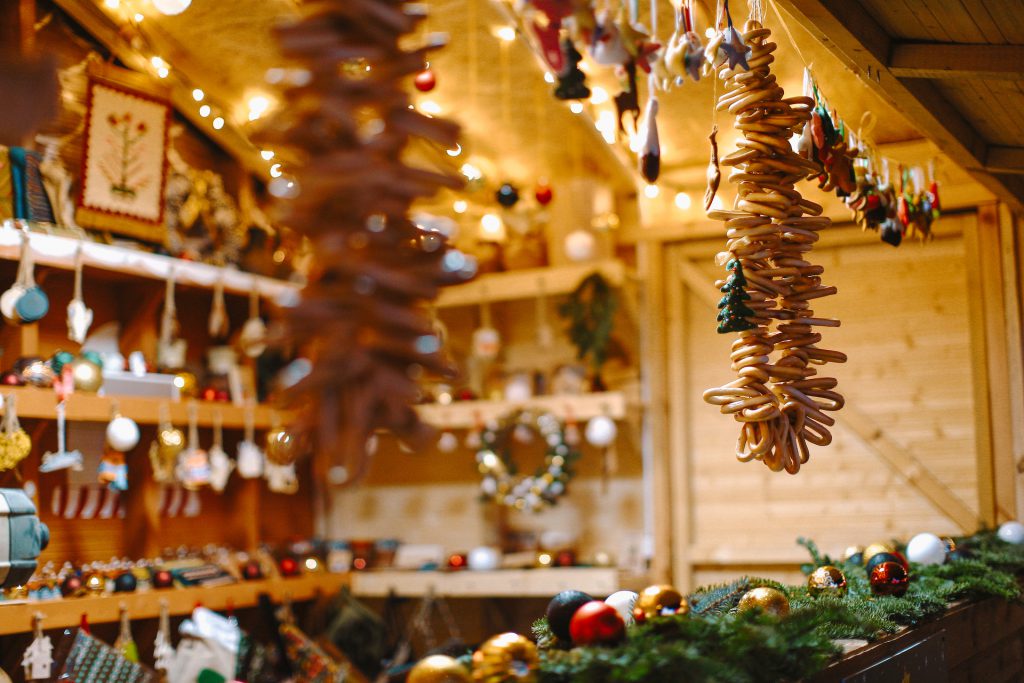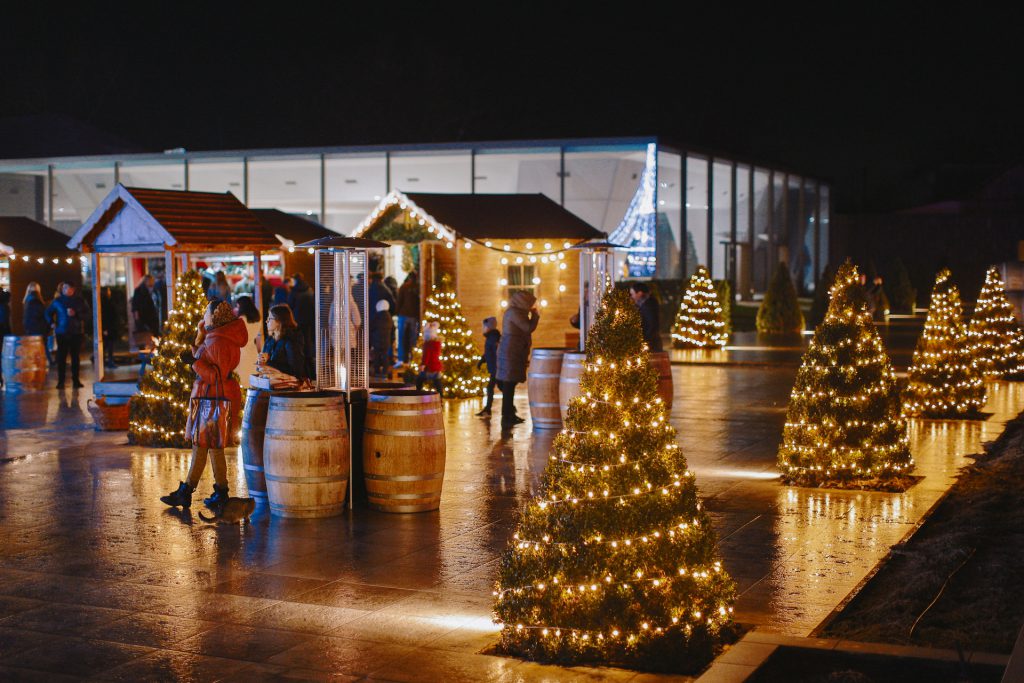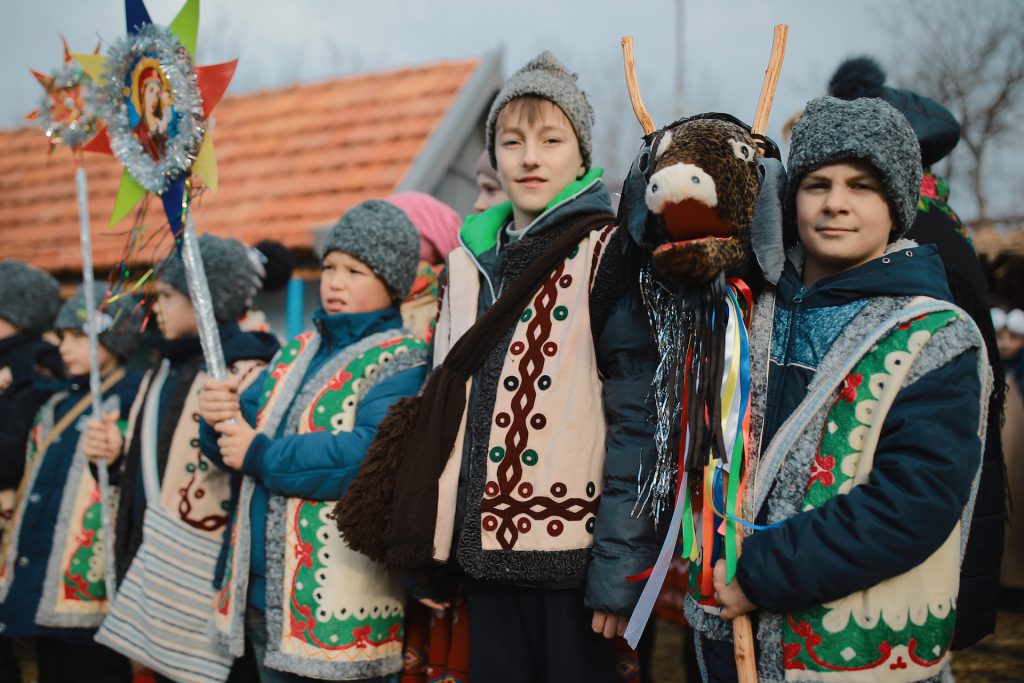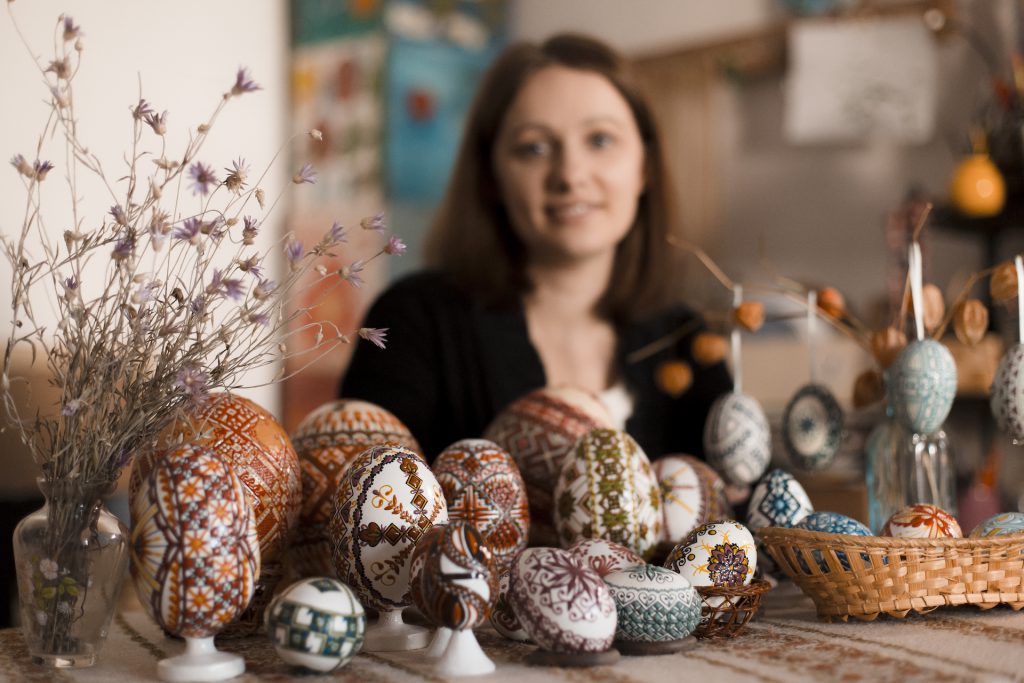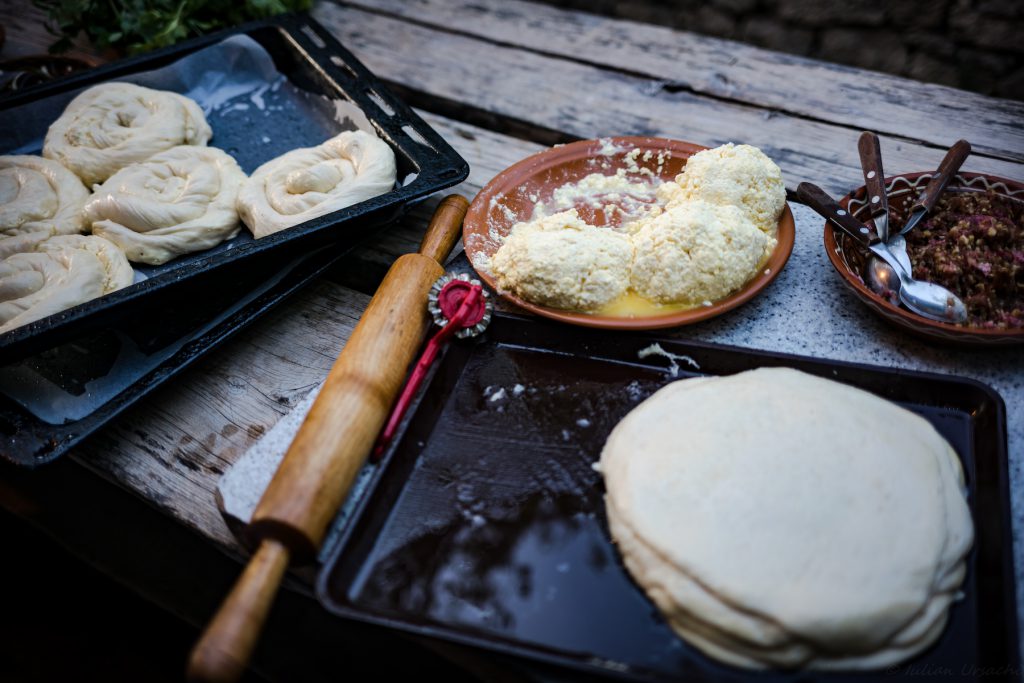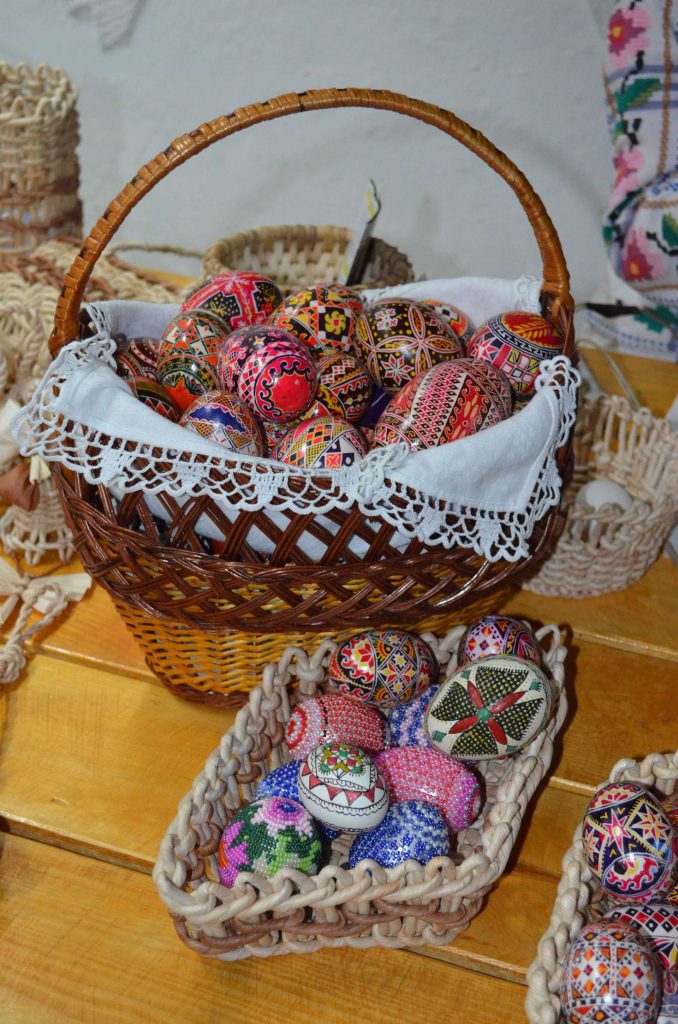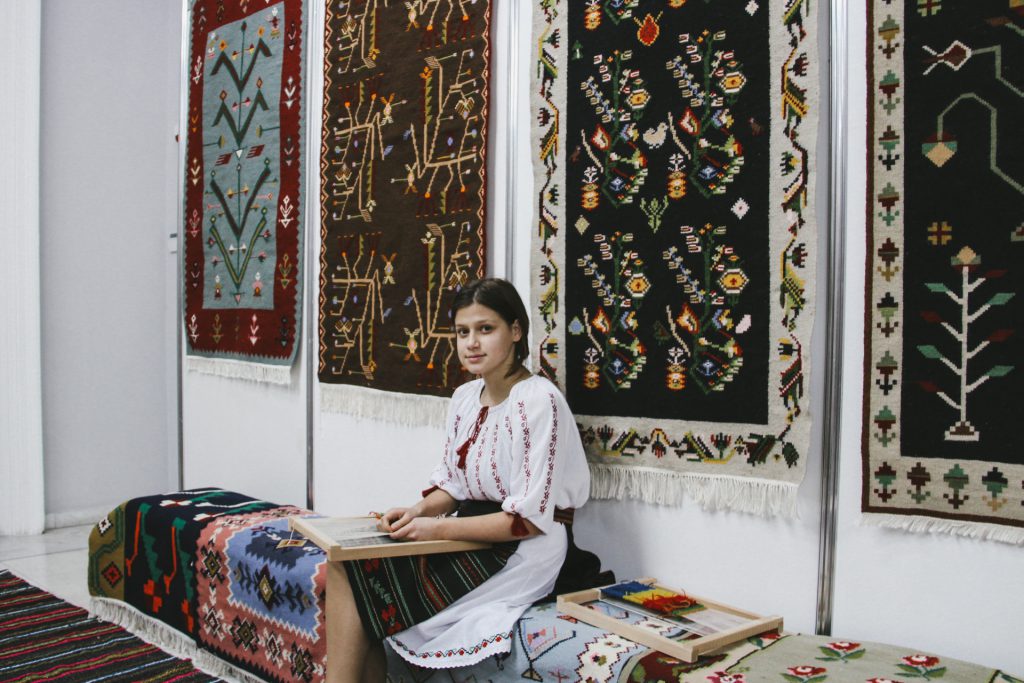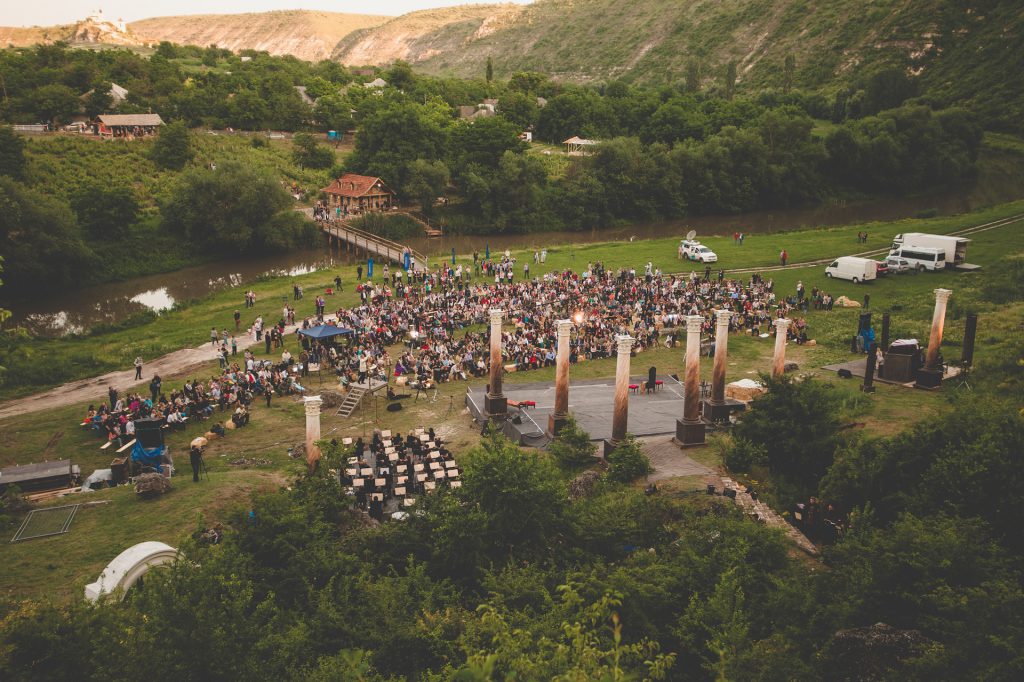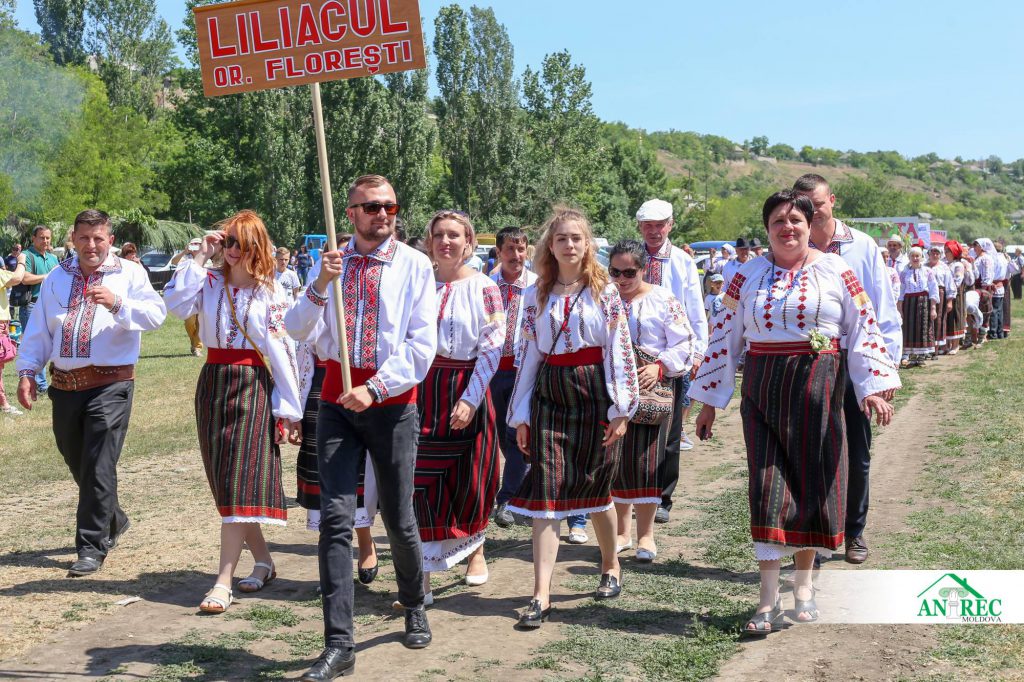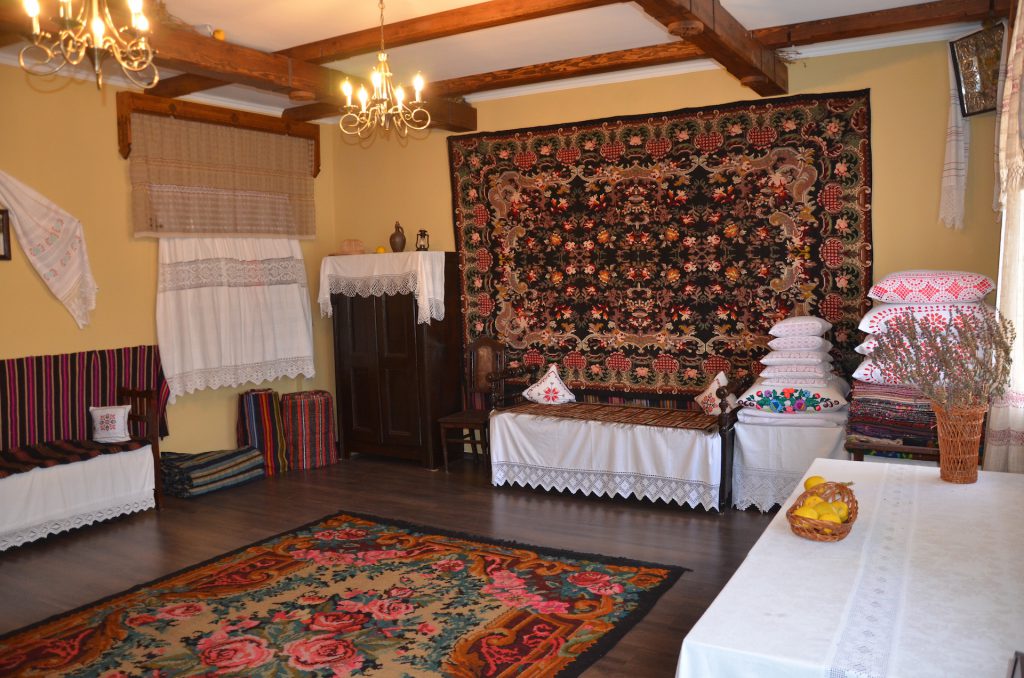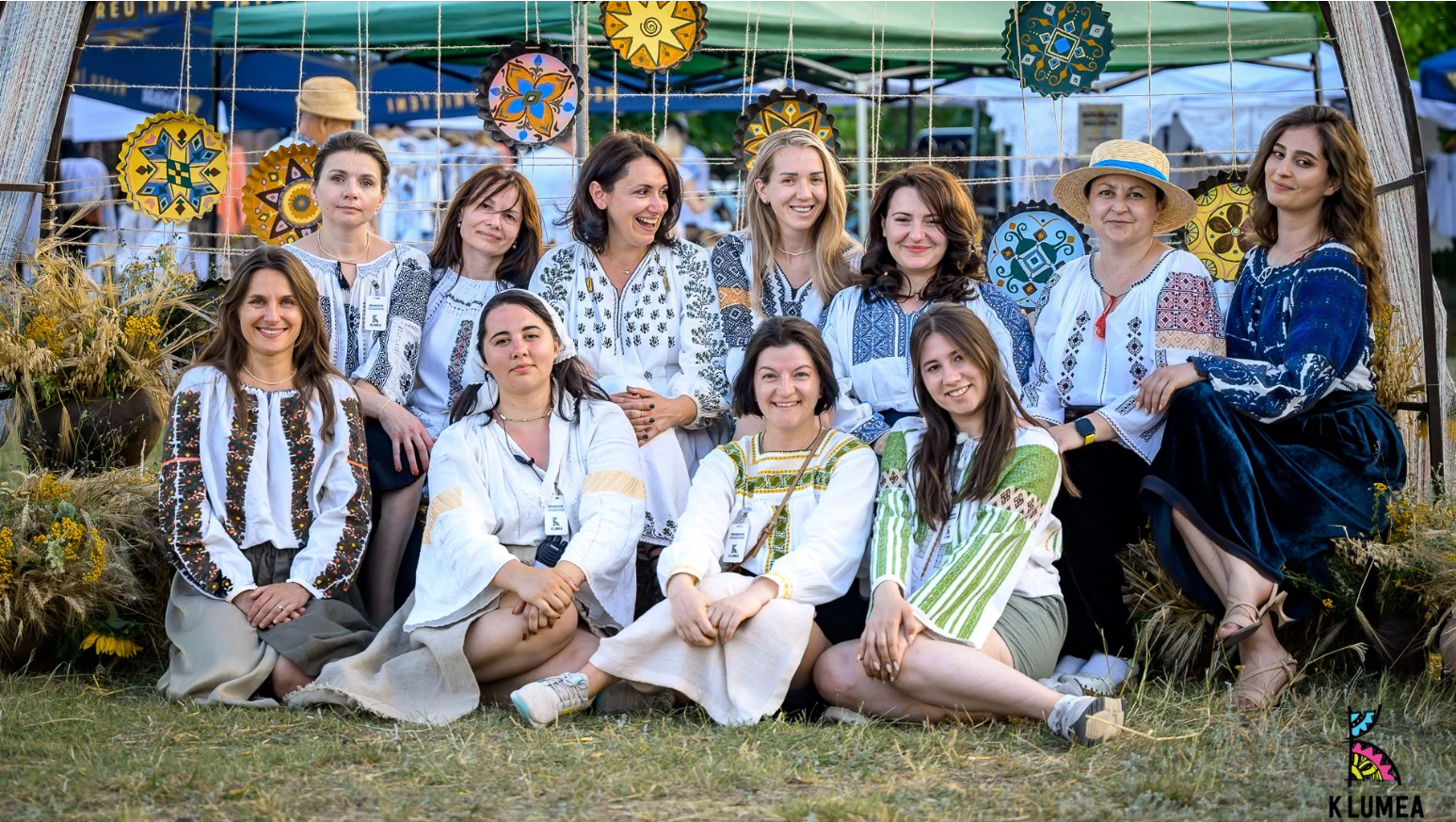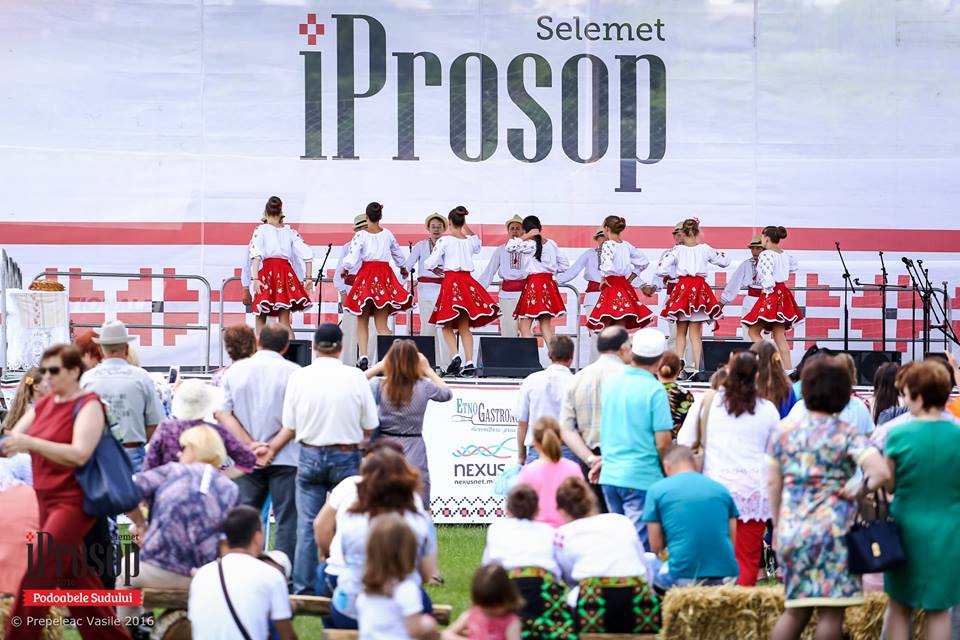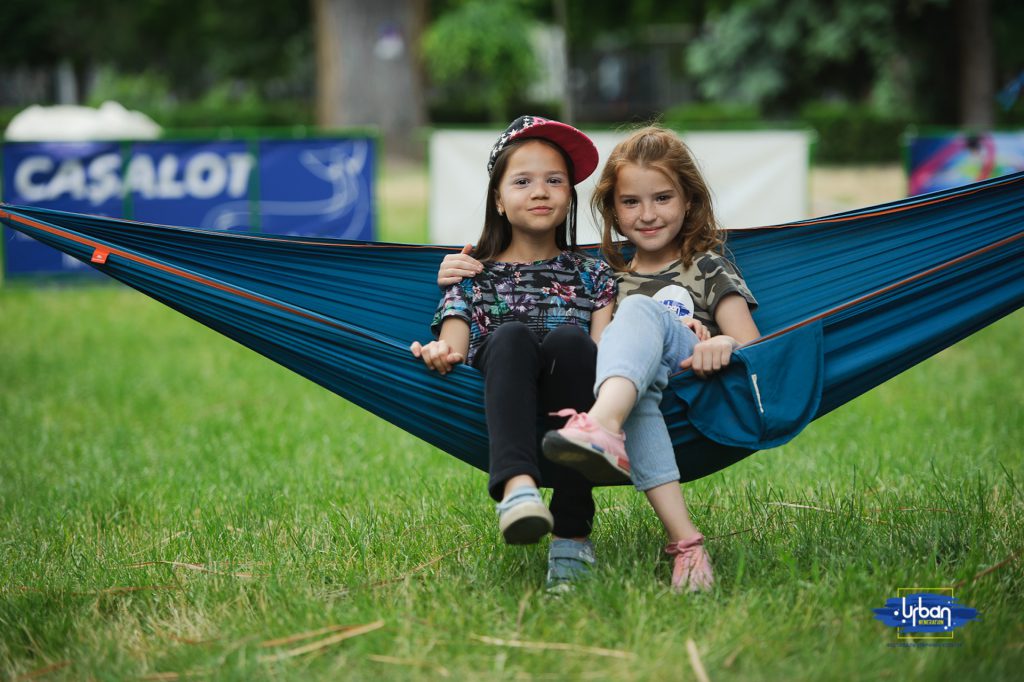One of the things that you’ll quickly notice when you visit Moldova is the richness of Moldovan culture and traditions. This deep and diverse cultural heritage is represented not only it the traditional crafts like the famous Moldovan traditional woven carpet and Ia, the traditional Moldovan embroidered costume, but also in holiday celebrations, music and festivals.
Cultural heritage
As you travel across Moldova you will certainly find some places, both in the Moldovan countryside as well as in urban Chisinau, where you will encounter and have the opportunity to become immersed in Moldova’s cultural heritage and traditions. Everywhere you go you’ll find friendly local people excited to tell you stories about Moldovan history and traditions so that you quickly find yourself feeling welcome like a true guest.
And remember, Moldova’s authentic culture is not just about tradition and the past. You will also find a vibrant modern culture and contemporary art scene with street art and graffiti, design and fashion, as well as an active co-working and tech scene. Moldova’s culture today embraces the authenticity of its past and present.
The Moldovan traditional woven carpet
Throughout history, the Moldovan traditional woven carpet has acquired a significance as a symbol of Moldovan handicraft creation that has evolved over the years, but has preserved the authenticity of traditions.
The period in which the predominant motifs of the Moldavian carpet were outlined is considered to be that of the 18th century – beginning of the 19th century. It was during this period that the ornaments characteristic of the Moldavian tradition, the reflected composition and the patterns used as a whole in weaving were determined. Even if for a period of time the tradition of weaving was stagnant, there was a period of relaunch which was possible due to the legacy of knowledge and love for one’s people and history.
Looking at a traditional carpet, you will see labor, value, tradition, secular roots, whole generations reflected in it. The effort behind the greatness of the Moldovan carpet is colossal. Usually, a group of at least 4 women worked on a carpet, one person could not cope with the complexity of the creation process. Weaving a carpet with a 6-7 sq. meter surface can take even a year or two of continuous work. Today, when the technique of weaving Moldovan carpets is not as well known as it was in the past, you can always visit the “Arta Rustica” Cultural Complex to find out as much as possible about this craft, the history of the carpet, but also to see what carpet weaving actually involves.
The traditional techniques of making carpets in Romania and the Republic of Moldova have been inscribed in the UNESCO cultural heritage. Thus, it was decided to register the traditional techniques of making scoarta (rug) In Romania and the Republic of Moldova on the Representative List of the Intangible Cultural Heritage of Humanity under a joint file for the Republic of Moldova and Romania.
“Ia” traditional blouse and traditional costume
One of the distinctive elements of the Moldovan people is the traditional costume – the result of work and creation for over hundreds and thousands of years, bringing together various representative forms of culture, rituals, holidays and national folklore.
At one time, the role of traditional dress was to indicate the position of each person in society and the hierarchical organization mode. One of the elements that has remained among the most known but also appreciated at the moment is the “Ia” traditional blouse. The “Ia” is a blouse made of white cotton, linen or gossamer, hemp, wool. It is decorated with embroidery in traditional motifs with a special emphasis on the neck, chest and sleeves. The traditional execution techniques are: weaving, sewing, embroidery. It is also important that Ia was not worn every day, but only on holidays, the catrința traditional skirt was worn with the opening aside, while the usual ones they had the opening in front.
On June 24, the day of Folkloric Wear is marked in Moldova. This day has the role of emphasizing the rebirth of traditional culture and promoting values in order to ensure the continuity of Moldovan traditions.
If you are wondering where specimens of the traditional Moldovan wear could be seen, well, the National Museum of Ethnography and Natural History has over 2330 objects of traditional wear. Also, at the Cultural Complex “Rustic Art” you will find plenty of new information about the traditional dress, thanks to the permanent exhibit that can be found in the hall dedicated to the folk costume.
Modern artists
Mihail Stamati’s Sculptures
Mihai Stamati’s sculptures are inspired by the desire to create much more than a simple product according to a predetermined design. The difference is to create valuable concepts that promote aesthetic culture. Mihai Stamati set up his workshop to launch sculptures that amaze with the complexity of simplicity.
His works have histories and they do not stop once they are completed, but he continues through the fact that they are loved by people who talk to others about the impressions created.
Mihai Stamati is the creator of the “Le gardien des souvenirs” (The guardian of souvenirs) art object. The project represents the design of a bench located in the public areas of Paris meant to make the city even more romantic. The main elements of the bench are the heart and the symbol of infinity. Another work for which Mihai Stamati is known in Moldova, are the UFOs made for the ARTCOR Creative Industries Center. These bold constructions are atypical benches that you will certainly not see in every park.
Access https://mikelesta.com to see other projects made by Mihai Stamati that you must definitely visit in Chisinau.
Street art
Until September 16, 2020, the bridge in the Telecentru district of Chisinau was one of the most representative places for urban art in Moldova and may well be called a true wall of memories. Here one could see graffiti works with whole histories, love dedications made by unknown artists, be they beginners or true experts. For the most part, the inhabitants of Chisinau fall into two categories when it comes to graffiti – on the one hand there are those who appreciate this type of expression as art and on the other hand those who consider graffiti an act of vandalism.
Urban Spirit Family is one of the well-known communities dedicated to graffiti artists where those interested in this culture from all over the country may join.
Walking through the city, you will surely see many examples of urban art, namely graffiti.
Mural painting
Lately, Chisinau has made considerable progress with mural paintings. Here, they are seen as ways to create communities united by the same values and visions, but also to give new life to some buildings that are considered gloomy.
We can also talk about the mural painting history of Chisinau’s Telecentru district Bridge. On September 16, 2020, the mural #Neampornit was inaugurated, which includes elements from the “Tree of Life” Republic of Moldova brand and has a length of 4 thousand meters. The mural is part of the national #NeamPornit campaign to relaunch domestic tourism initiated by the Moldovan Investment Agency. The Moldova Competitiveness Project, funded by USAID, Sweden and the UK, supported more than 100 enterprises: agro-pensions, wineries, rural pensions, travel agencies during the pandemic crisis. The mural was made by the team of artist Dmitry Potapov.
Another mural of almost 700m2 can be seen on the walls of the fence of the Chisinau Electric Transport Authority (RTEC). It is dedicated to solidarity in combating violence against women and was carried out as part of a campaign launched by UN Women Moldova with financial support from Sweden.
Many residents of Chisinau have heard about the history of the “Un Pic De Love” (“A bit of love”) project. On 78, 31 August 1989 street, next to the National Museum of History, you can admire the mural reminiscent of the elements of a traditional Moldovan carpet. Nicolae Morozov authored the sketch, while street-art painter Dmitrii Potapov transposed the painting into reality during 10 days of work. Throughout the launch event, the wall was illuminated, the painting becoming animated.
ATU Winery, the first urban winery in Chisinau, offers its visitors the opportunity to admire a mural right on the walls of the winery. The surface of the painting has a length of 130 meters, and was made by artist iZZY iZVNE. If you visit the winery, you will see a composition that illustrates a man and a woman, with the details remaining to be seen by you yourself when being in front of the building.
Traditional holidays
Christmas
Christmas is celebrated in Moldova on December 25 new style, and on January 7 old style.
There is no place in the world where holidays are more beautiful than in Moldova. Moldovan people are rich in traditions. We have a variety of customs for the winter holidays.
On the day and night of Christmas Eve only children and young men announce the Birth of Jesus. In some villages the caroling with songs of yore is also practiced. Groups of carolers are made up of married people, and on this occasion they raise funds for the local church. On Christmas morning, the caroling begins with the “star”, which involves the formation of groups of three children, wearing a colored paper star and crowns on their heads. Housewives greet them with bread and salt, this signifies the joy of the caroled hosts. Another custom is to put a kulich (traditional woven bread) and a glass of water on the table on Christmas Eve, because it is believed that the souls of the dead come to their homes that night, taste the kulich and wet their mouths with water.
The tradition of the 12 Apostles. Before Christmas, housewives prepare 12 dishes. All dishes are placed on the table on Christmas Eve, garlic heads are placed on the corners of the table, and the dishes are placed in a line reminding us of the “Last Supper”.
On Christmas Eve, women also bake a kulich (traditional woven bread) in the shape of a wreath, symbolizing the crown of Jesus.
Also on Christmas Eve, women bake the incomplete eight-shaped kulich, also called Christmas kulich (craciunel). They are hung on the wall, next to icons, where they remain until the spring equinox. The man of the house then takes the Christmas kulich with him when he goes out in the field to plow for the first time. After the first furrow is drawn, the man breaks the Christmas kulich into three pieces, one of which he puts under the furrow. He gives another piece to the animals in the household and eats the third.
On Christmas day, the housewives go “sharing” (giving kulich, sweets), the godsons visit with their godparents, younger brothers and sisters – visit with the older ones and the village organizes a big Hora dance.
These traditions are passed down from generation to generation and create a special atmosphere and a fairytale Christmas.
At Christmas, all roads lead home to parents, grandparents and close relatives. This holiday unites everyone around a festive meal, with traditional dishes and mulled wine that are gladly offered by wineries and guesthouses across the Republic of Moldova.
Easter
Easter e is a holiday whose symbolic value marks the beginning of the year and the return to life. The resurrection of Jesus Christ, considered the Son of God in Christian religions, is seen as the celebratory event of Easter, the beginning date of this holiday also marking the beginning of the Christian ecclesiastical year.
To fully mark this date, Christians follow various procedures designed to prepare their souls and bodies for Easter Holiday. There are a number of habits that have been rigorously followed for a duration of six weeks per year, since time immemorial. Painting eggs remains one of the most well-known and practiced customs, their presence on the Easter table being mandatory, and in many cases, eggs are taken to church to be consecrated. Painting the eggs red has an explanation – according to Christian legend the Mother of God, who had come to mourn her crucified son, placed the basket of eggs near the cross and they were died red by the blood dripping from Jesus’ wounds. Another tradition that involves all members of the family is the clinging of painted eggs.
The Easter customs represent the communion of man with the divinity and the connection with nature in this period and it is precisely for these reasons that Easter holiday is one that traditionally reunites the family.
Memorial Easter
The Easter of the Blessed or Memorial Easter (Pastele Blajinilor) is one of the oldest popular holidays that is strictly observed in Moldova. Every year, Memorial Easter is celebrated depending on Easter day (one week after) and marks the reunion of the living with the dead by commemorating the moments spent together.
The significance of the holiday is in passing the happiness that people feel due to the Resurrection of Christ on to those who have passed away.
Usually, on this holiday, Moldovans meet at the church or cemetery where several traditions take place – one of them is to take care of the graves of the dead and light candles. The housewives have the task of preparing all the gifts on the graves of the deceased – a traditional towel on which they place kulich, Easter cake, Easter painted eggs and a bottle of wine. The priest comes to the graves and sanctifies the gifts brought to the cemetery by relatives of those who died. Finally, these gifts are usually given to needy people or children.
Some superstitions that are taken into account during this holiday are also specific to usual Sundays in Moldova – when it is a bad sign to sew, clean, wash clothes.
The traditions and customs of Easter vary depending on everyone’s visions of this holiday, but one thing remains certain – this is the day when Moldovans commemorate those who passed away.
Sanziene
Celebrated every year on June 24, is our traditional Sanziene feast. Yet another reason to celebrate is to mark the Nativity of John the Baptist. The name Sanziene comes from the Roman goddess Santa Diana, the guardian of the forest wildlife and hunt, also associated with the fairies of the field. Love and fertility are the symbols of this feast, while people believe that the heavens open on the eve of this day and the Sanziene start dancing and the dance has a love-related symbolism. Dancing Sanziene, besides symbolizing the sunrise have the power of curing the sick ones, making the crops of hard work more abundant while protecting animals and birds. Also marked on June 24 is the summer solstice – the longest day of the year and, at the same time, the shortest night.
According to the legend, on the night of June 23, the most curious of the girls used to put Sanziene (Lady’s bedstraw) under the pillow and falling asleep with the hope that in the morning they will remember their intended one from the dream.
Dragobete
Dragobete is known as a day for lovers (similar to the Valentine’s Day), celebrated by Romanians every year on February 24. This is a feast known for numerous customs. Let us now go step-by-step and unveil the details.
Dragobete is the God of youth and joy, taken over from the ancient Dacians and later on assimilated with the protector of youth and love. In local mythology Dragobete is no one else but the son of Baba Dochia (Lalla Chafia), which marks the beginning of the spring.
“Dragobete kisses the girls”. You have probably heard this expression, while the explanation of its origin is as follows:
A beautiful Romanian countryside tradition implies that straight after the lunch served to celebrate the Lover’s Day, the young lads would pick up a bouquet of forest flowers and start a courtship ritual. They start running after the girls they fell in love with, trying to kiss them, and if one could catch and kiss a girl, it meant that the engagement and marriage of the two could follow. Usually, towards the evening, they would pass the news over to the family as well as to the rest of the village.
It goes around that those who take part in Dragobete feast, will have a productive, enjoyable and prosperous year and the illness will never touch them. If it rains on Dragobete, it implies that one could expect a beautiful springtime. On this day no one should feel upset or have any bad thoughts and no weeping, as these could do harm to one’s love life. A superstition goes that if the girls did not meet any lads on this day, then they will not find their love for the rest of the year.
Young girls would keep sanctified Basilicum under their pillow, believing that Dragobete will help them find their beloved.
It would be a sin to slaughter animals on this day. On the contrary, one should give special care to the animals on Dragobete; otherwise, the importance of mating would be totally lost. It is desirable that on that day the young people drink cherry stem tea in order to enjoy love all year round. On Dragobete, one should abstain from hard physical work while cleaning up one’s house would be a good augur.
The Martisor tradition and its symbols.
The Martisor is one of the most famous authentic symbols of the spring in the Romanian space, celebrated every year on March 1. Martisor is a small handmade decoration object, made of white and red twisted woolen or silk strings, which supposedly brings luck. Usually, people give each other Martisor as a gift on the first day of spring and it should remain pinned on one’s clothing and saved until the last day of March.
Why the white and red colors?
Well, there are various legends explaining the symbolism associated with the color of Martisor.
The first one tells about the abduction of the Sun by a Dragon, who imprisoned a beautiful girl in his palace. Seeing all this, a brave young man decided to take the stronghold by storm and free the girl.
The battle was a tough one, but the brave boy defeated the Dragon and saved the girl.
The sun was back to the sky and the springtime resumed, but the young fighter lay wounded in the Dragon’s palace. The drops of his blood fell on the snow while emerging on these very spots were the first harbingers of the spring – the Snowdrops.
It is also said that since then people honor the memory of the brave young lad by tying together with a string the white and the red flowers. Red color symbolizes love and courage of the young man and the white color stands for the Snowdrop – the first spring flower to bloom.
Yet another legend says that the Spring was strolling in a forest, while all of a sudden, there appeared a small Snowdrop (Galanthus nivalis) popping up from the snow in a bush of a blackthorn.
The Spring decided to help them popping up by removing snow through the thorny branches. This angered the Winter badly and the cold icy wind and frost were unleashed to destroy the flowers. The Snowdrops have frozen, but the Spring did not let itself be defeated and protected the Snowdrops with the palms to warm them up. While so doing, the Spring injured her palm with the thorns and the drops of blood fell on the Snowdrop, bringing it back to life. Thus, the Spring has beaten the Winter, and the colors of Martisor symbolize red blood drops on the white snow.
It is also believed that the feast of Martisor appeared during the reign of Roman Empire, by the times when the New Year was celebrated in the month of Martius/March (the God of war and fertility). The red color symbolizing war while the white one – peace.
This custom could have originated some 8000 years ago. That is because the Romanian archaeologists discovered necklaces with river pebbles painted in white and red.
Nowadays, it is still a tradition to hang one’s Martisor at the end of March on a fruit tree. It is believed that is brings prosperity and happiness to people’s homes while all the wishes made when handing the Martisor on a fruit tree will definitely come true.
The tradition of celebrating Martisor in the Republic of Moldova is also live in Romania, North Macedonia and Bulgaria
The Independence Day
The Independence Day is a public holiday in the Republic of Moldova, celebrated to mark the adoption of the Declaration of Independence on August 27, 1991. Following declaration of its independence, the Republic of Moldova became a sovereign and independent state. The transition process towards the democracy has taken off in June 1989, in Chisinau. On august 27, 1989, there takes place the Great National Assembly meeting at which people voiced their support in favor of having the Romanian language as a state language and the return to the Latin script in the MSSR. On 27 August 1991, Moldova declares its independence on the grounds of the Declaration of Sovereignty, signed and approved earlier on 23 June 1990. This process was rather lengthy and cumbersome, which is explained the pressure exerted by the USSR on the people of the Republic of Moldova. Making changes in the social and cultural life as well as in the politics was set out as the major challenge.
Nowadays, the Moldovans celebrate the Independence Day every year. The ceremony starts with flower laying to the monument of the Stephen the Great and Holy. Organized on this day are various cultural and artistic events/performances, traditionally preceded by the President’s speech. All of the festive events serve to emphasize the paramount values of the Republic of Moldova along with the inspiration to strengthen the national identity, traditions and customs crucially demanded by the nation for its efficient and transparent functioning.
Limba Noastră
Limba Noastra [Our language] is celebrated every year on August 31, giving the tribute to the state language.
Celebration of this event dates back to August 27, 1989, when the Great National Assembly was called for in Chisinau, demanding declaration of the Moldovan language as a state language along with reintroduction of the Latin script.
Subsequently, on August 31, 1989, the MSSR Supreme Soviet voted the law on the establishment of the state language and declared this day the national holiday.
In the early years, celebration of this day was marked by unveiling a bust of a famous writer/poet in the Alley of Classics in the Central park of the capital, followed by various cultural events.
Annually, celebration of Limba Noastră begins with flower-laying ceremony to the monument of Stephan the Great by the officials of the Republic of Moldova and to the monuments of the classics of the national literature. Likewise organized are various events, such as exhibitions, master classes, presentations of new books, and in the evening, as a rule, the celebration ends with a show in the Great National Assembly Square.
Arts
Folk dances
Moldovan folk dances became well known and appreciated locally and internationally thanks to the diversity of performance, choreography and tempo range. Those who want to learn more about the Moldovans could do it while watching folk dances. This way they could get a flavor the emotions, culture and values cherished by the people of Moldova. The Moldovan traditional folk dances are valued as an important intangible part of the cultural heritage. One could easily breakdown the folk dances into a number of categories according to the events taking place in the life of a Moldovan. Here one could talk about dances related to various natural phenomena, life events, dances that show the bravery and courage and dignity of humans.
Dance patterns differ from village to village and from one locality to another. The differences are obvious through the set of musical instruments used, the level of expression, style of folk costumes as well as through the movement and tempo preferences. Thereat, women and men dancers use different technique while the folk dances performed in pairs are rather complicated indeed.
Sârba and Hora stand among the most famous and often performed folk dances in Moldova. The Sârba dance is famous for its fast tempo and a counterclockwise movement, while the movement in Hora is much slower, more like an artistic show full of inspiration.
The all-times legendary Joc was the most famous National Academic Folk Dance Ensemble. The name of the Ensemble is similar to the folk dance also called Joc. The national folk dance troop took part in a large spectrum of the international festivals, winning high distinctions next to the folk ensembles from other countries, such as Romania, Russia, France, Belgium, Italy and others.
Sculptural arts
The development of the sculptural arts in the Republic of Moldova dates back to the Cucuteni-Trypillian period. The coat of arms of the voivodes contain certain elements still found on some of the historical buildings, churches and fortresses. An important role in sculptural arts belongs to the traditional sculpture – wood and stone carving. Moldovans commonly use the finely carved elements to decorate their houses, fences, columns as well as for general decor.
There are certain distinguishing features between various types of sculptures. The development of sculptural arts was influenced by different social and historical events, thus mirroring religious, funerary, and community events along with creation of professional sculptural masterpieces.
Cultural heritage stands out as the basic value of a nation through which its identity is perceived both locally and internationally. Professional sculpture was marked in Moldova by the masterpieces of Alexandru Plămădeală, creator of the monument of Stephen the Great, inaugurated in Chisinau in 1928. One could see some of Plamadeala’s works, donated by his wife, at the National Museum of Arts. The famous Alley of Classics in Chisinau appeared at the initiative advanced by Alexandru Plămădeala. Likewise belonging to the sculptor are a number of well-known busts made in commemoration of such famous personalities as Alexei Mateevici, Toma Ciorbă, and Bogdan Petriceicu Hasdeu.
Lazar Dubinovschi is another remarkable sculptor who contributed to the cultural heritage of Moldova. During 1951-1953 he worked on creation of Grigori Kotovsky’s monument in Chisinau. Nowadays, his works could be seen in Pushkin Park of the capital city. These are the busts of Mihai Eminescu, Dimitrie Cantemir, Miron Costin, Gheorghe Asachi, Vasile Alecsandri.
Mosaic artwork
A mosaic is a pattern of small ornaments of different colors made of pebbles, glass or ceramics used to create a comprehensive image of the landscapes or personalities.
Quite a number of buildings in Moldova still have some remnants of mosaic art created during the Soviet reign. Specific to this period was to decorate walls with mosaic images of the national heroes, known teachers and/or doctors, important public actors, meaningful places/events.
The earliest mosaics in Moldova appeared in the early 60s. During this period, there appeared the first artisans capable of doing this type of art. Mosaic-decorated walls appeared in public transport/bus stations as well as on the wall of important public institutions. Since the 1970s, mosaics become more popular and could be now seen even inside of the buildings, such as, schools, hospitals, public institutions. Mainly, the messages conveyed by the mosaics used to encompass the ideals of the communism, such as, sharing friendship relations, living in a cooperative community, nourishing love for the homeland, and showing love for the fruits of one’s work.
Since the process of making mosaic was costly and time-consuming, the authorities paid more attention to the maintenance of buildings decorated with mosaic. Attained to the mosaic was much higher price and importance. Once the USSR system collapsed, the mosaic lost its importance gradually vanished in an attempt to eliminate this type of propaganda. Subsequently, this form of art has lost its importance along with the need of maintaining it in a special way. Despite all this, still found around Chisinau some intact pieces of mosaic works. These were moved to the new location and restored at the decision taken by the public authorities. This usually happened when the old buildings with mosaic were demolished.
Painting
The murals played a great role in determining the tendencies in the development of painting in Moldova. One could easily find samples of murals inside of the churches or outdoors as dedicated to prominent personalities, thus highlighting their importance and advocating their way of living. Moreover, discovered in Moldova could be both, the exterior as well as the interior painting. The interior painting retained its religious origin, while the exterior one is mingling with a particular landscape through the colors used and the figures painted against the overall landscape.
The Causeni Church of the Assumption of Our Lady is one of the unique objects of the cultural heritage that confirms existence of the medieval painting art in Moldova. Nowadays, the Church rehabilitation project is in progress with the view of restoring the architecture of the building and the old paintings on the walls.
The National Art Museum of Moldova was founded in 1939 by Alexandru Plămădeală and Auguste Baillayre. The Museum is found on the 31st of August 1989 Street in the historical center of the city. Here one could visit various exhibitions with original paintings of Valentina Rusu-Ciobanu, Eleonora Romanescu, Mihail Grecu, Elena Bontea, Sergiu Cuciuc and many other national artists. The works displayed in the museum are arranged in 5 sections: Medieval Art, Folk Creation, Moldovan Art, Russian Art, Western European and Oriental Art, in addition to the scenery and decorative applied art. It is worth noticing that the purpose pursued by the museum goes beyond simple display of valuable works to the public. It is also meant to keep intact the cultural heritage of a country for the noble purposes, such as, various studies, educational processes and recreation.
Among temporary exhibitions arranged in the museums one could see the Japanese woodblock prints from the late Edo and Meiji periods; personal exhibition of the artist Tudor Zbârnea, the Anniversary Exhibition of Maria Saca-Răcilă; and Eleonora Romanescu’s commemorative exhibition.
The institution in charge of creating favorable environment for the upcoming artists is the Academy of Music, Theater and Fine Arts. The institution was founded in 1940 and offers studies in the field of Fine Arts, Design, Multimedia, Music, Theater and History of Culture.
There are numerous art galleries worth visiting in Chisinau where one could discover the magic of local art and its influential powers: Constantin Brancusi Gallery; Muses Art Gallery; and the Peperete Art Gallery.
